University of Pennsylvania vs. Cornell University Football Rivalry at Franklin Field
21st Feb 2022
The University of Pennsylvania-Cornell University football game used to be a big event. The Penn-Cornell rivalry is one of the oldest in college football, first played in 1893. For a long time the game was a Thanksgiving Day staple played at Franklin Field in Philadelphia, often to very large crowds. Forty-three of the first forty five games were played on Thanksgiving Day. Franklin Field, the home of Penn football was also the site of numerous firsts in the history of the game.
Ivy League football games today have been relegated to third tier status by the media and by fans. Today's college football is dominated by the SEC with teams like LSU, Alabama, and Georgia. Other teams with national followings and good programs such as Ohio State, Penn State, Notre Dame, and Stanford also attract large TV contracts and thus audiences. Before the current era of big spending on college football teams, on-line sports betting and fantasy teams the Ivy League was a dominant part of college football, and the Cornell-Penn rivalry was a special one. Hard as it is to believe today, Ivy League teams were regularly national champions during college football's early years.
The first game in 1893 was played at the Germantown Cricket Club in the Manheim neighborhood of North Philadelphia, and Cornell got whipped 50-0. The Philadelphia Times recounted the game and noted that the score probably would have been even more lopsided, but the game was shortened by 25 minutes. The scene at the 1893 game was described in the 1934 game program, "The great autumn game was marked by 'flying interference,' mustachioed players, thrilled feminine 'shouters' atop parked tallyhos, referees who wore derbies and kid gloves and carried bamboo canes, low wooden stands comfortably filled with enthusiastic eye-witnesses, the most spontaneously impromptu sort of parody-singing and rooting imaginable, a half dozen reporters and perhaps a sketch artist." 3,500 fans were on hand to watch the inaugural match and most of them left the game singing "After the ball was over."
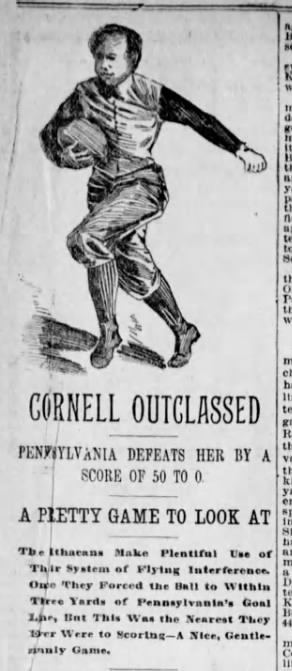
The highlight of the first Cornell-Penn game from the Philadelphia Times
The second game in 1894 was played at the old University Field on 37th and Spruce Streets, where dormitories on the Penn Campus now stand. Franklin Field is the oldest two-tiered stadium in the country, with a seating capacity of 52,598. It was originally opened in 1895 for the first running of the Penn Relays; the original wooden grandstands were taken down in 1922 and the stadium was rebuilt. Penn and Cornell played their rivalry at Franklin Field until 1964 because the weather was believed to be better in Philadelphia than in Ithaca. The first game at Franklin Field in 1895 was also a lopsided affair with Penn winning 46-2 on a field that was wet from heavy rain the prior day and a snowstorm during the game. Penn finished the year 14-0 and were national champions, their second consecutive title. Franklin Field has the distinction of being the first stadium built in the United States with a scoreboard.
Early newspaper coverage of the games portrayed a bleak outlook for Cornell. The New York Times previewed the 1896 game and wrote that, "The Cornell men do not expect to win, they do expect to score. They also expect to keep Pennsylvania's score down to four touchdowns."
The 1898 game was also a memorable one. Rain began to fall in the morning, and it turned to snow before noon so when the teams came out to play they found several inches of snow on the ground and the markings of the gridiron were obliterated. The game was tied 6-6 at the half and the players were shivering and wet when they went to their locker rooms. Penn changed into new dry uniforms while Cornell failed to bring additional ones, giving Penn an advantage during the second half, leading to a 12-6 victory.
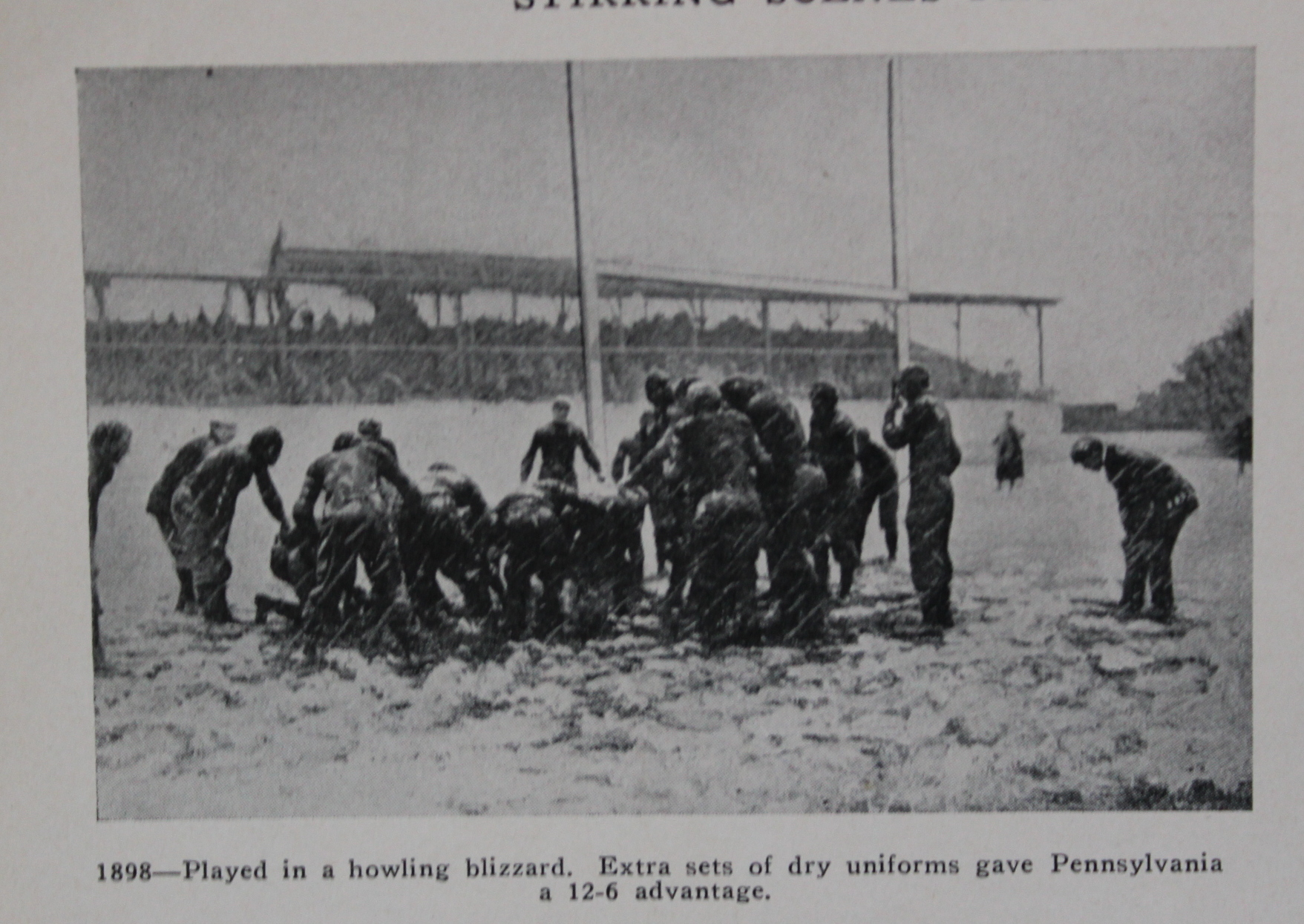
The snowy, sloppy 1898 Cornell-Penn game
Cornell was outplayed and out coached for the first eight meetings of the team. It wasn't until 1901 that Cornell got its first victory. They wouldn't win again until 1913.
Famous coaches would be part of the rivalry from the start. Glenn Scobey Warner, also know as “Pop” Warner, was a legendary football coach who coached at six schools in total including at Cornell between 1897–1898 and 1904–1906; he coached Stanford from 1924-1932, winning the national championship in 1926. He was inducted into the College Football Hall of Fame as a coach in 1951. Warner also helped start the popular youth American football organization, Pop Warner Little Scholars.
Apparently early college football games were somewhat fluid. They were scheduled at two 35 minute periods but during the 1902 Cornell-Penn game Cornell was winning 11-0 at halftime so they asked the referee to sound out the Pennsylvania coaches on shortening the second half from 35 to 25 minutes. The request irritated the Penn team and they declined to shorten it, believing they could come back. Two touchdowns and two conversions later Penn went on to win the game 12-11. At the time touchdowns counted for five points, not today's six.
The 1906 game ended in a 0-0 tie. Penn made a heroic goal line stand, stopping Cornell six times within the 5-yard line towards the end of the game and took possession of the ball on the 2-yard line. In those days the field goal posts were in the end zone so Penn had to kick from behind one of the goal posts. The kicker also had to kick into a stiff wind. The result was a terrible kick that went out of bounds on their 4-yard line. Penn was able to hold on for a few more downs without giving up the ball before the clock ran down.
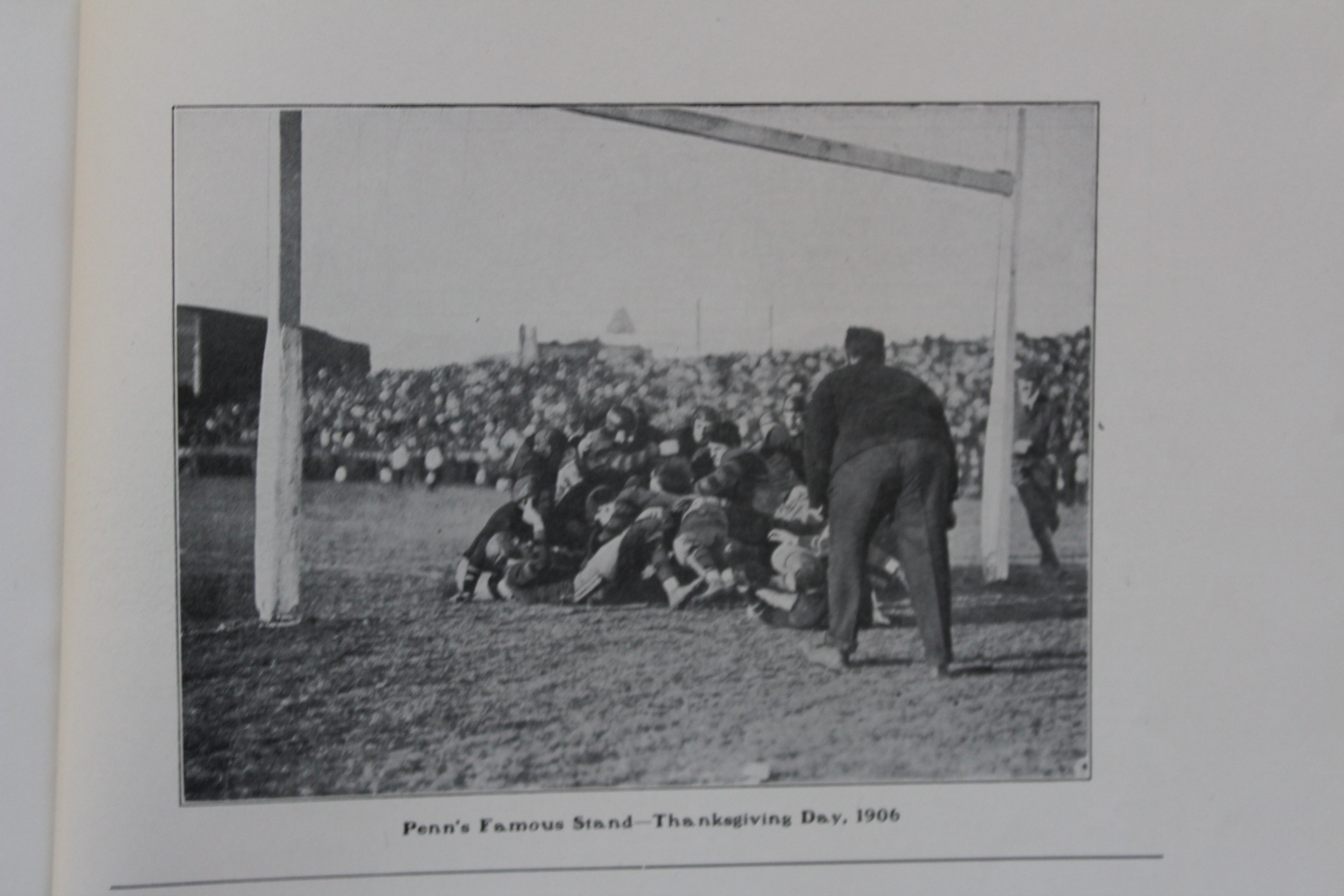
The goal line stand of Penn in the 1906 game. The referee seen from behind is "Big Bill" Edwards of Princeton
The innovation of putting numbers on the back of player's uniforms started at Penn and Franklin Field. Until a few years before the First World War numbering of players was not done. Many coaches resisted the idea of putting numbers on the backs of players, fearing it would aid their opponents.
John Heisman graduated from the University of Pennsylvania in 1892 and served as the head coach of the football team from 1920-1922. He is pictured below in action in the 1920 Penn-Cornell program. Interestingly, Cornell won two of the three games played while Heisman was coaching Penn.
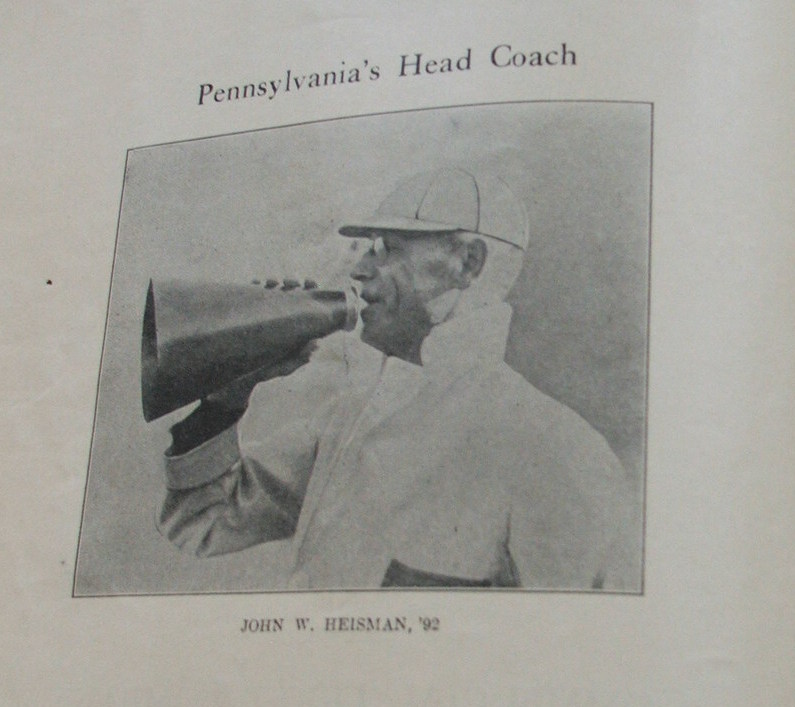
One of the memorable plays in the rivalries history occurred at the 1926 game, the famed "hidden ball" play. While Cornell led 10-0, Jesse Douglas, a fleet halfback was put into the game one play before "the roof caved in." As the Pennsylvania backs all pretended to have the ball, the Cornell team followed Douglas while Al Wascalonis raced 66 yards to score without being touched. The game ended in a 10-10 tie.
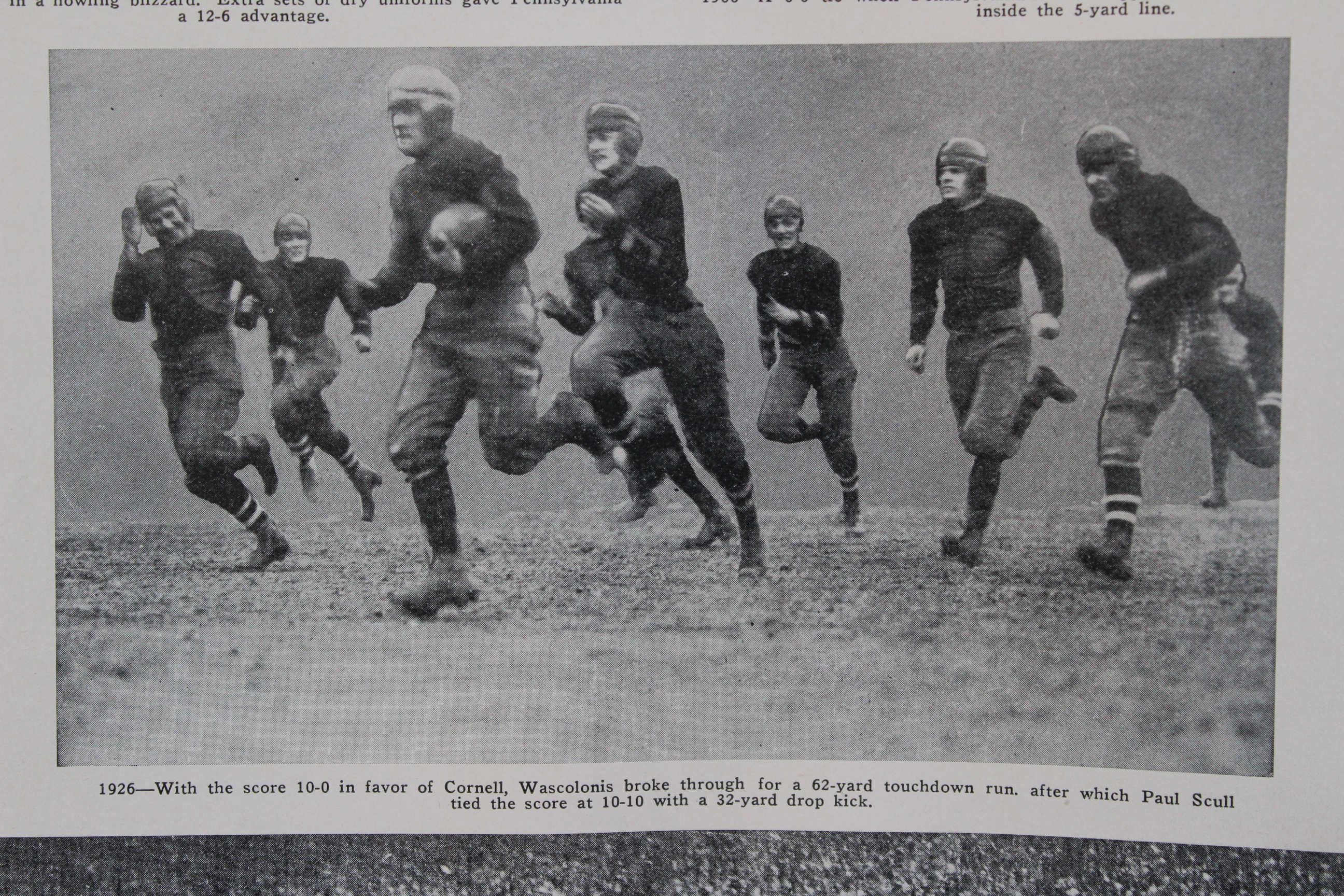
Although not a game against Cornell, Franklin Field was the location of the first televised football game in history. Penn's season opener against Maryland was broadcast live on October 5, 1940. It also hosted the Army-Navy game 18 times.
The 50th anniversary Cornell-Penn game was played in 1943 and attracted a crowd of between 55,000 and 60,000. The 1948 game, which was for the Ivy League title, attracted a massive 78,000 fans when temporary seats were added to Franklin Field.

The perfect cover illustration for a game played on Thanksgiving
Probably the best player to ever play in the rivalry was Check Bednarik, pictured below in the 1946 game program when he was serving as the captain of the Penn team. Bednarik joined Penn in the middle of 1945 after serving in the Air Force. He served as an aerial gunner and participated in 30 missions over Germany. He would go on to play pro football for the Philadelphia Eagles for thirteen years, playing in eight pro bowls. He is a member of the College Football Hall of Fame and the NFL Hall of Fame. He was also the last "60 minute" man to play in the NFL, meaning he played the entire 60 minute game, something that isn't done anymore in our current era of frequent substitutions.
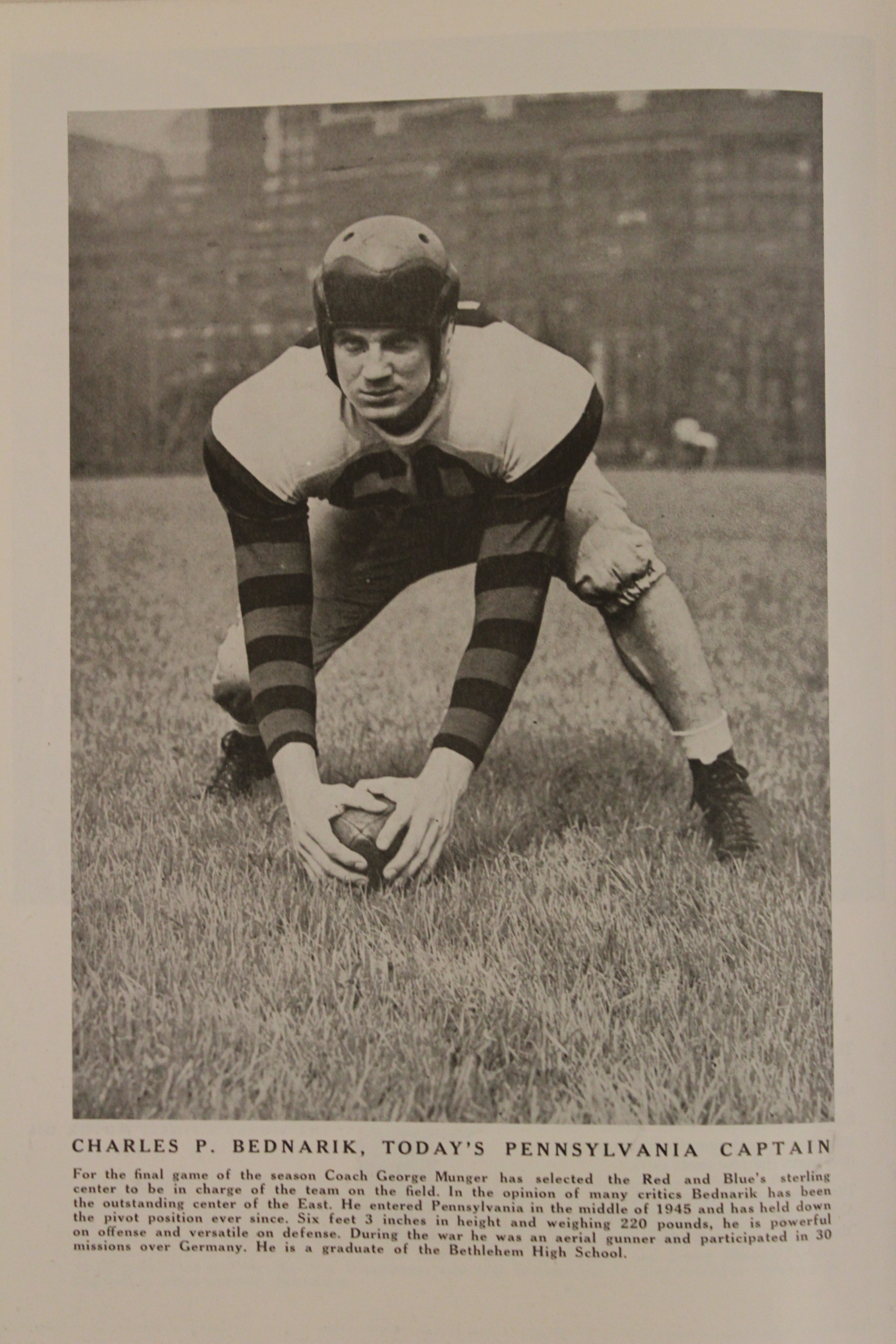
Franklin Field was also the the home of the Philadelphia Eagles from 1958 through 1970. Vince Lombardi's only NFL playoff loss was at Franklin Field in 1960 when the Eagles beat the Packers.
In addition to one of the great early rivalries of the game, Cornell-Penn programs are notable for some of the most interesting program covers done in all of college football. Especially noteworthy are those done between 1919 and 1927, all of which are stunning.
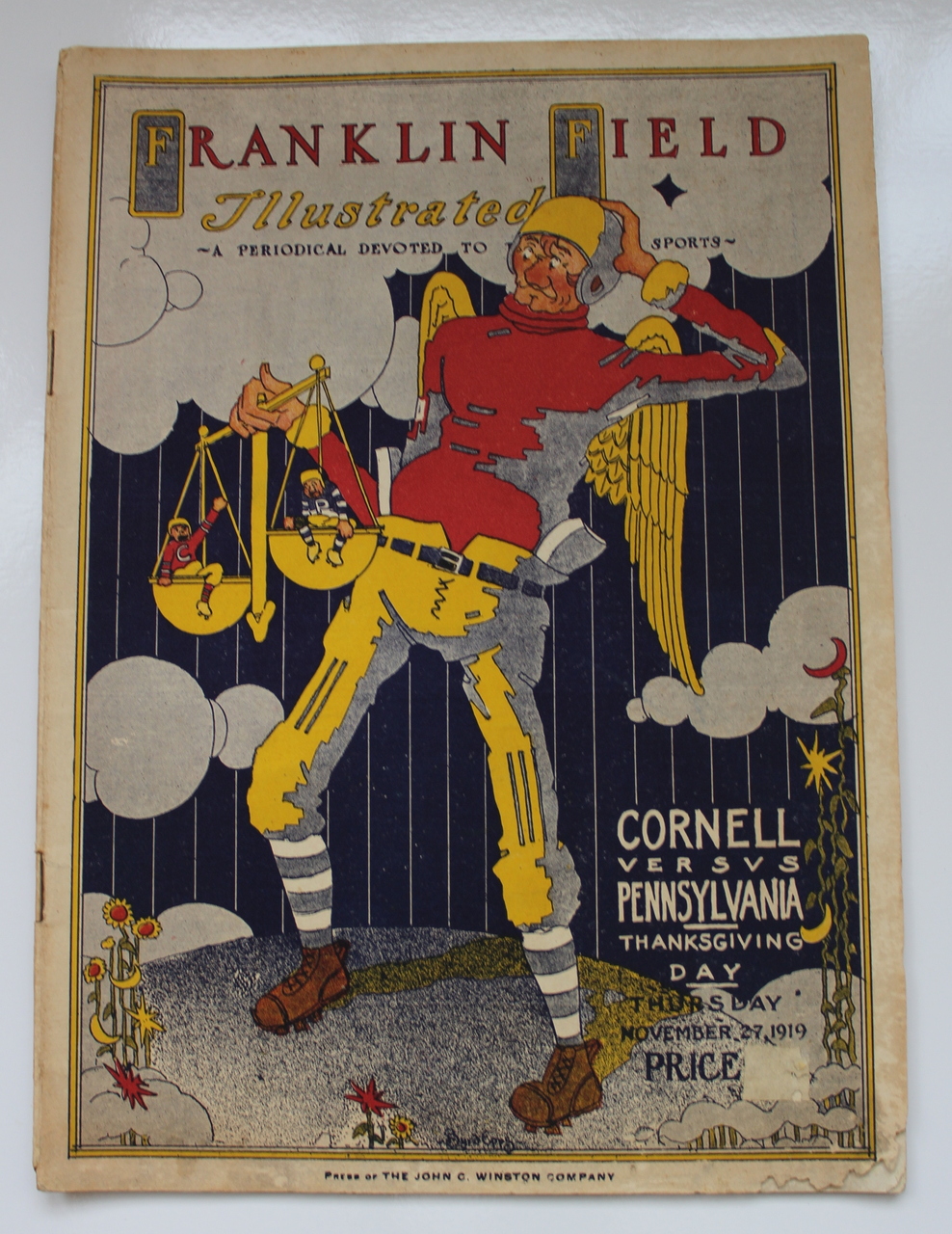
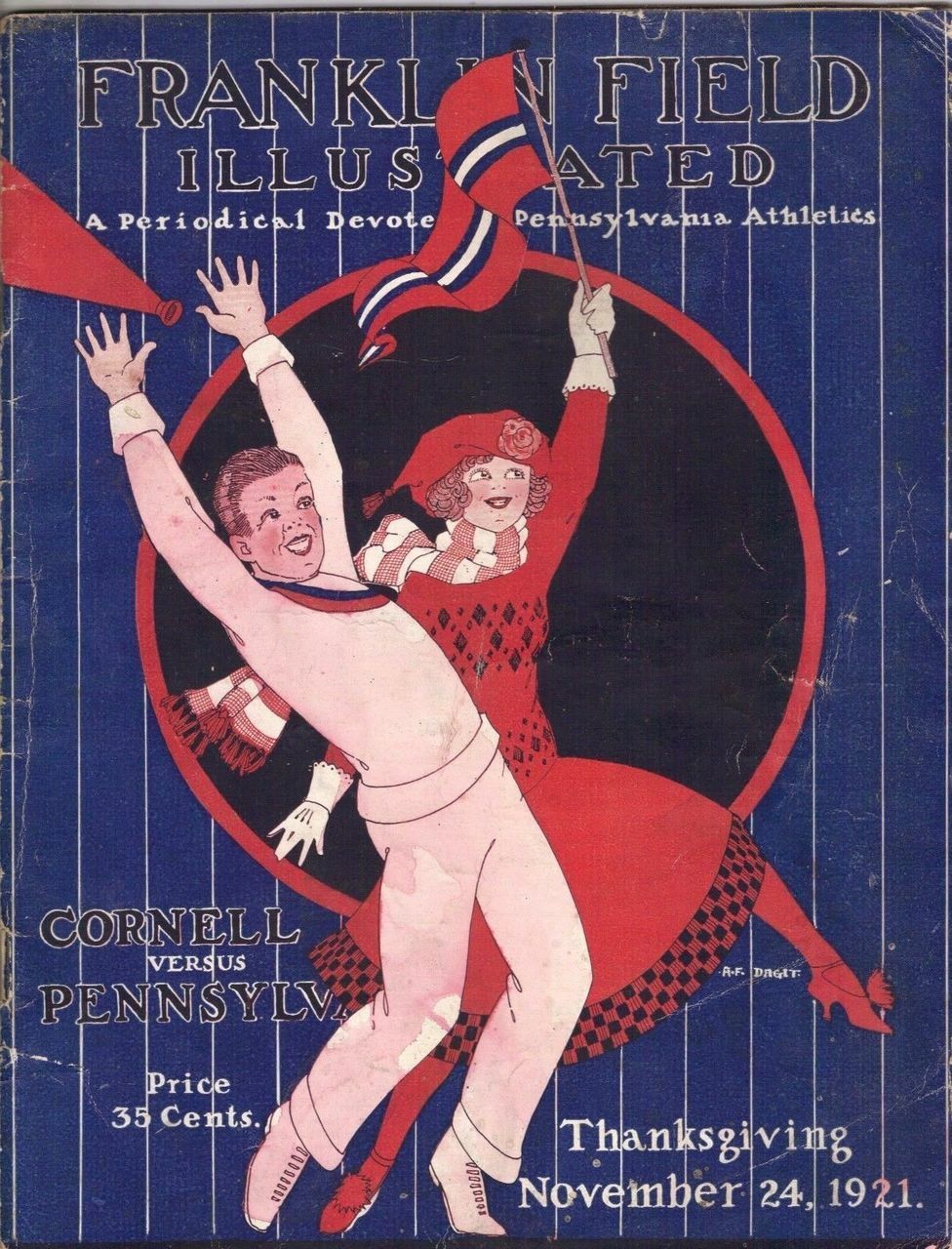
The cover illustration on the left from 1919 is one of the greatest of all time and was done by "Byrd Epps," a student at Penn graduating in 1920. It shows a perplexed angel standing atop the earth with a scale. On either side of the scale is a player from Cornell and Penn, as if the angel is trying to decide who will win. Not surprisingly, the Penn player is higher and the Cornell player below is protesting. The cover on the right from 1921 shows a Penn cheerleader and an elated female fan in high heels celebrating.
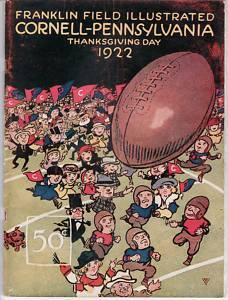
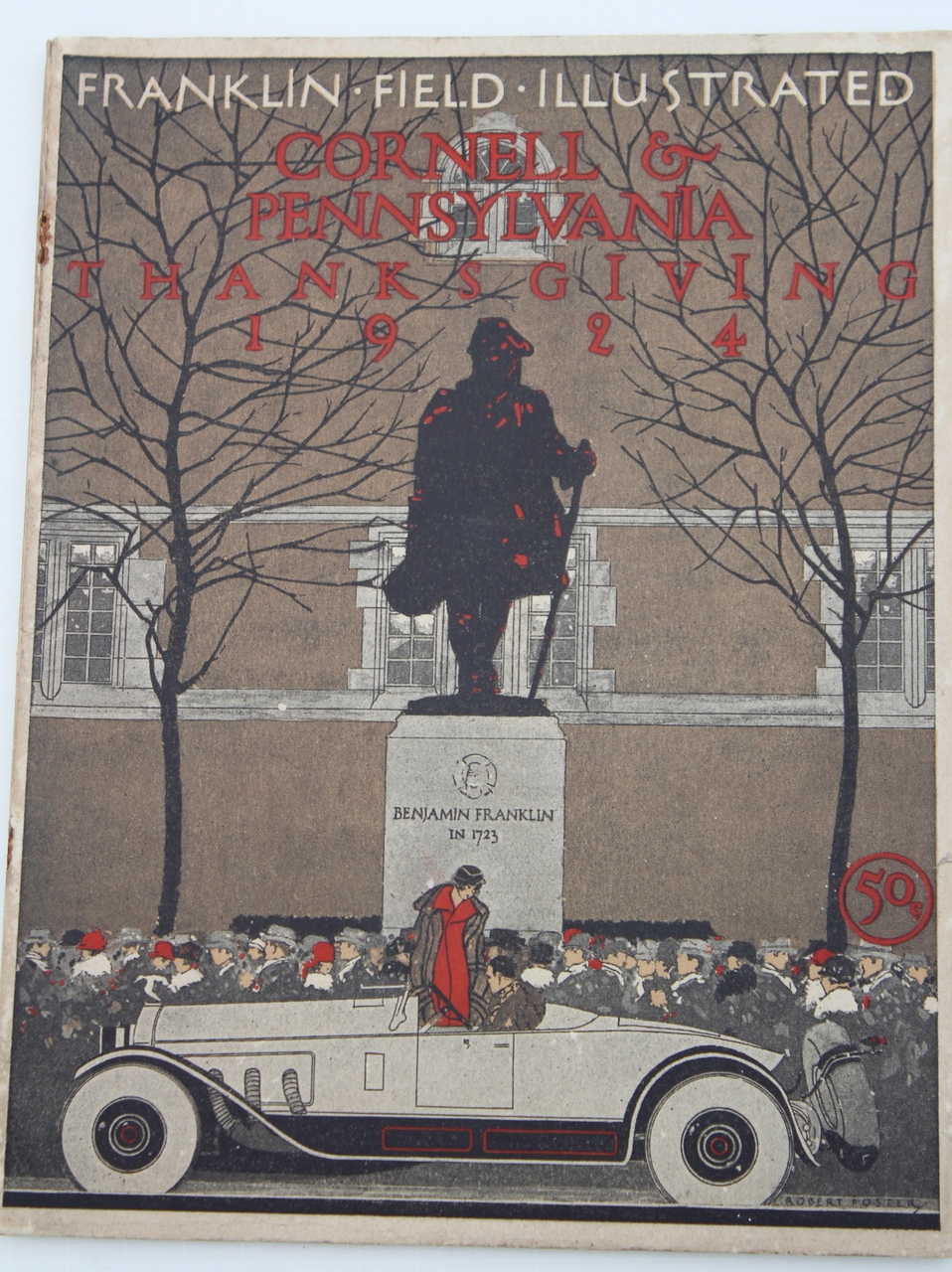
The 1922 program shows a giant football with scores of players underneath and Penn and Cornell pennants in the background. The 1924 program done by Robert Foster shows a luxury Duesenberg automobile in front of a Ben Franklin statue with well dressed fans between the two. College football’s first radio broadcast occurred at Franklin Field on Thanksgiving Day 1922 and Cornell beat Penn 9-0.
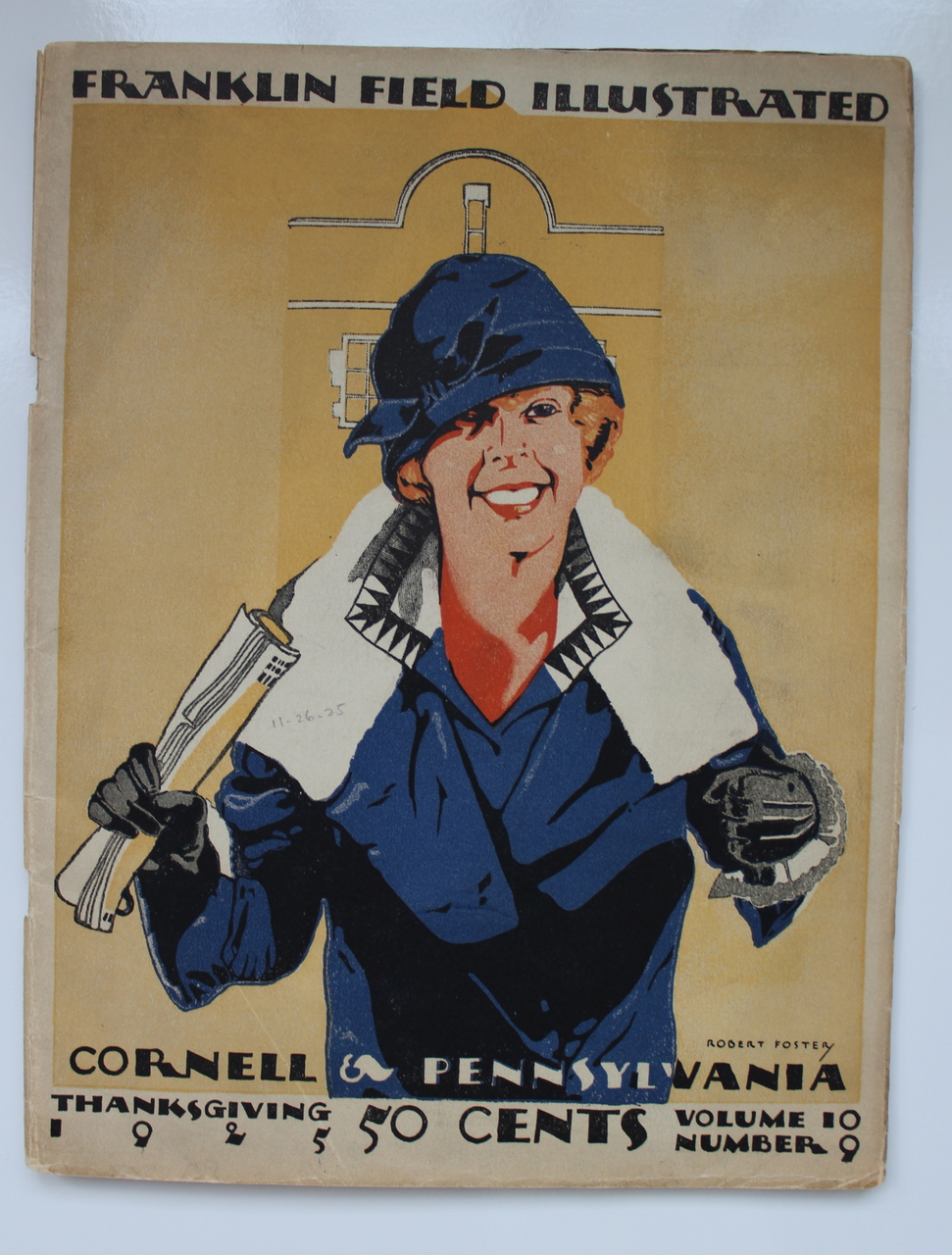
The 1925 Penn-Cornell program was also done by Robert Foster and shows a Penn fan from the era wearing the typical cloche hat.
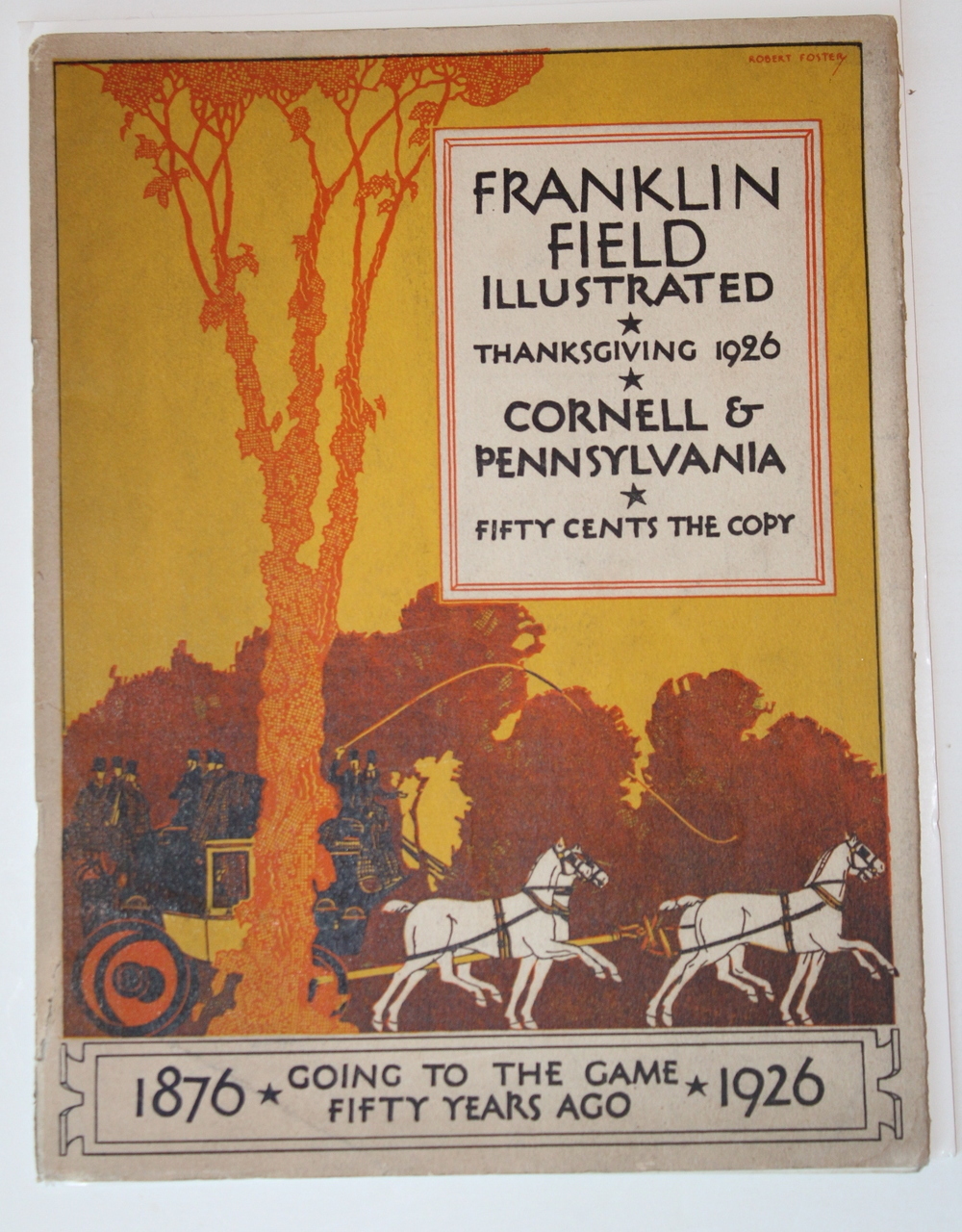
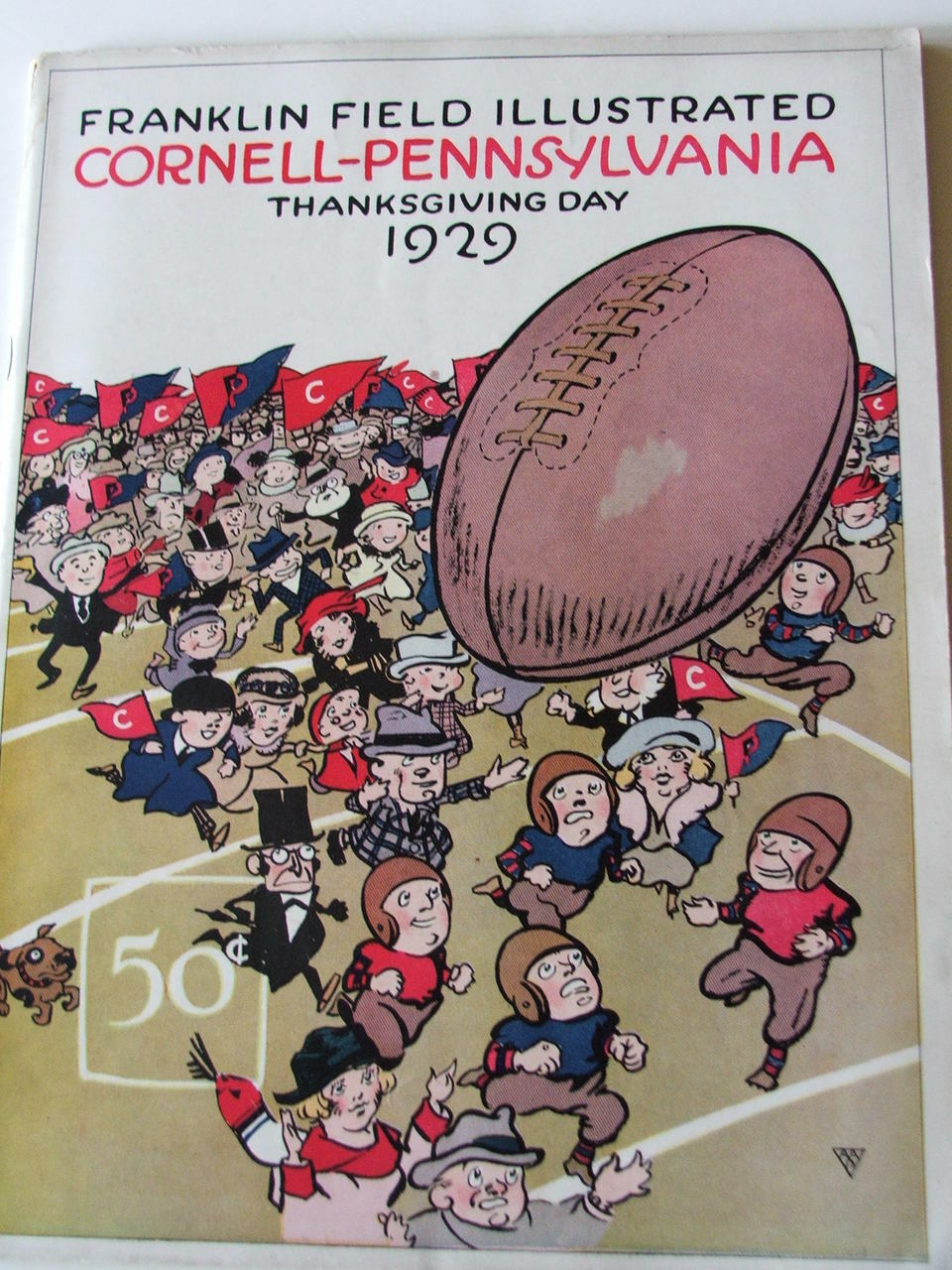
The 1926 Cornell-Penn program features a carriage being drawn by prancing white horses. It is a somewhat eerie cover unrelated to football. The 1922 cover was so popular it was repeated in 1929 with a lighter background.
The tradition of playing on Thanksgiving day lasted until 1960 and then ceased. Although more convenient for everyone to be home with their families on Thanksgiving, undoubtedly something was lost in the annals of college football when this great rivalry ceased to be played on Turkey Day. The 1961 game played two days after Thanksgiving drew only 12,204 fans.
Ivy League football has faded in prominence over the decades in favor of power teams built around big recruiting budgets and scholarships, and the Cornell-Penn series has faded along with it. Since 1995, the winner of the Cornell-Penn football game has been awarded the Trustees' Cup, although it doesn't have the luster of those early games. Today, instead of 50,000-80,000 spectators Cornell-Penn games are lucky to get 10,000 fans at a game.
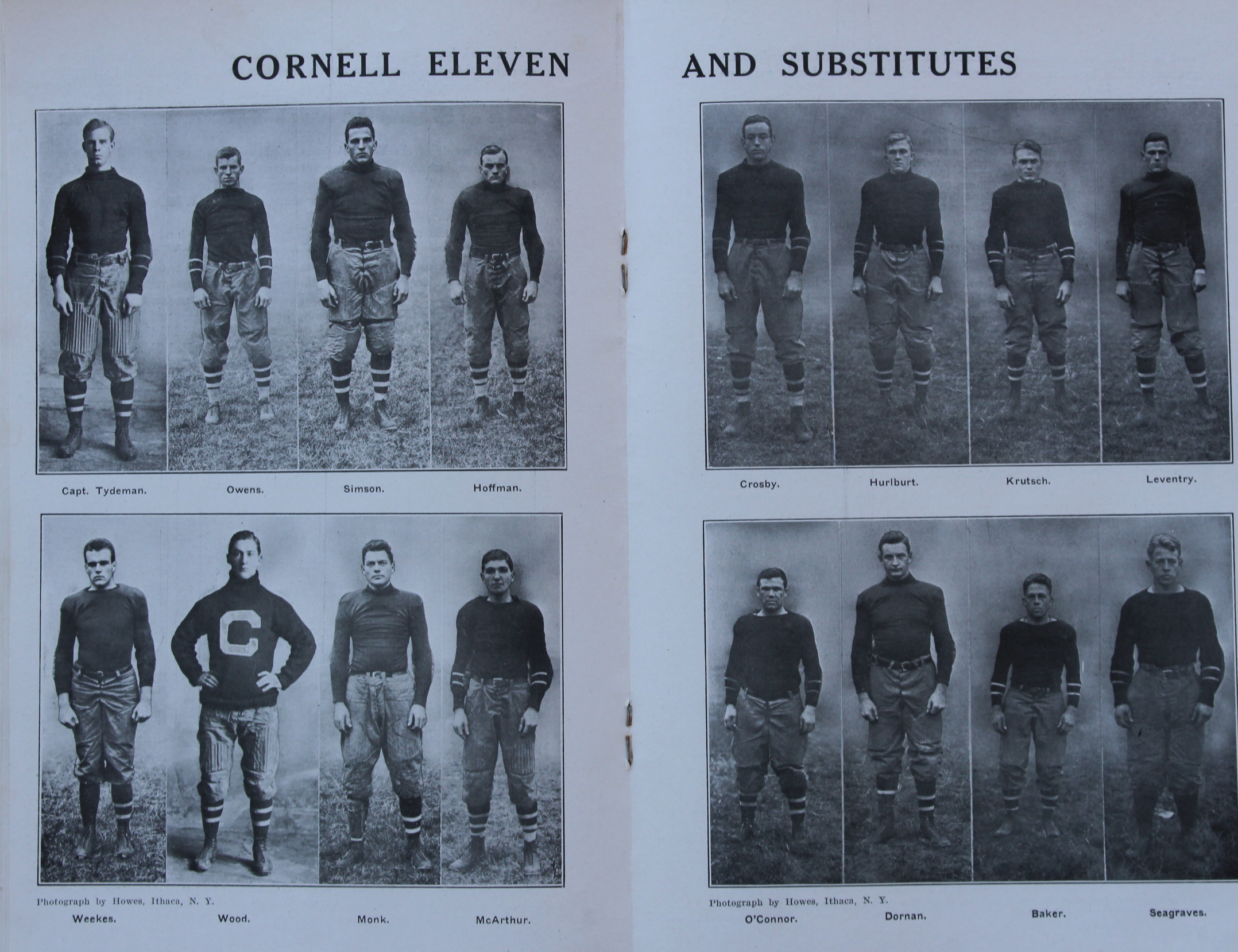
The 1909 Cornell football team with their baggy pants and no shoulder pads
Fortunately for us we can relive this great rivalry through old Penn-Cornell football programs. Fenway Park is treasured as the oldest surviving baseball stadium in the country. Franklin Field continues to he held in high esteem not only for the running of the Penn Relays, but as the oldest college football stadium in the country.